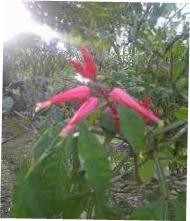Amargo
(Quassia amara)

Description
Quassia amara, also known as amargo, bitter-ash, bitter-wood, or hombre grande (spanish for big man) is a species in the genus Quassia, with some botanists treating it as the sole species in the genus. The genus was named by Carl Linnaeus who named it after the first botanist to describe it: the Surinamese freedman Graman Quassi. Q. amara is used as insecticide, in traditional medicine and as additive in the food industry. Quassia (genus) amara (species) is an attractive small evergreen shrub or tree from the tropics and belongs to the family Simaroubaceae. Q. amara was named after called Graman Quassi, and enslaved healer and botanist who showed Europeans the plant's fever treating uses. The name "amara" means "bitter" in Latin and describes its very bitter taste. Q. amara contents more than thirty phytochemicals with biological activities in its tissues including the very bitter compound quassin. Therefore, it is used as insecticide, in traditional medicine against lot of disease and as bitter tasting additive in the food industry. All plant parts are useful for medicinal properties and the bark extracts are mainly used as flavoring in drinks but also for insecticides. Q. amara grows wild, but can be cultivated. Trunk wood, roots, bark, stems, leaves, flowers and seeds are harvested to gain extracts of the plant. For its beauty, quassia is also grown as ornamental plant. Quassia amara is marketed and used interchangeably with another tree species Picrasma excelsa, sharing the common name of quassia (and many of Quassia amara's constituents and uses). P. excelsa is with up to 25 m in height much taller, and occurs farther north in the tropics of Jamaica, the Caribbean, the Lesser Antilles, and northern Venezuela than Quassia amara. Also in herbal medicine in the United States and Europe very little distinction is made between these two species of trees; they are used identically and just called quassia. Quassia amara is an understorey plant in neotropic rainforests and humid sites and mostly abundant in young forests. Therefore Q. amara is native in the tropics of Southern America. More exactly in the Caribbean (Trinidad and Tobago), Central America (Costa Rica, Nicaragua, Panama), Northern South America (French Guiana, Guyana, Suriname, Venezuela, Brazil, Peru) and in Western South America (Colombia, Argentina).
Taxonomic tree:







